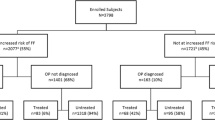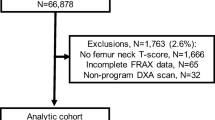Abstract
Summary
Use of the FRAX (Fracture Risk Assessment Tool) tool to assess fracture risk is the most common practice worldwide. Our findings suggest that in treatment-naïve women with osteopenia treatment would be cost-effective for approximately one-third of the study population and nearly half of the subjects over 75 years, according to the Greek-specific FRAX-based thresholds.
Introduction
When evaluating a patient with low bone mineral density (BMD), fracture risk estimation is of paramount importance. Fracture risk assessment using the FRAX tool is the most common and most studied practice worldwide.
Patients–methods
The primary aim of the “ACROSS” study was to record the 10-year probability of major osteoporotic fractures and hip fractures, using the Greek version of the FRAX tool, in a rather representative population of 230 postmenopausal treatment-naïve women with osteopenia. Secondary aims of the study were to identify (1) the risk for fractures according to age and the years from menopause, (2) the proportion of patients qualifying for treatment according to the Greek cost-effective FRAX thresholds, and (3) the perception of both the patient and the treating physician regarding the estimated fracture risk.
Results
The mean 10-year risk was 10.7% ± 6.6 for major osteoporotic fractures and 3.4% ± 4.2 for hip fractures. For women up to 75 years of age, the 10-year risk for major osteoporotic and hip fractures was 8.8% and 2.1%, respectively, while for women over 75 years, the risk was 15.2% and 6.6%, respectively. Patients generally believed that they had low fracture risk independently of age, while the physicians considered that the risk increases with advancing age.
Conclusions
According to the Greek-specific FRAX-based thresholds, the administration of osteoporosis treatment would be cost-effective for approximately one-third of the study population and nearly half of the subjects over 75 years. Patients are not fully aware of their fracture risk.
Similar content being viewed by others
Data availability
Data will available upon request.
References
Barrett-Connor E (1995) The economic and human costs of osteoporotic fracture. Am J Med 98:3S–8S
Colón-Emeric CS, Saag KG (2006) Osteoporotic fractures in older adults. Best Pract Res Clin Rheumatol 20:695–706
Becker DJ, Kilgore ML, Morrisey MA (2010) The societal burden of osteoporosis. Curr Rheumatol Rep 12:186–191
Melton LJ, Chrischilles EA, Cooper C, Lane AW, Riggs BL (1992) Perspective. How many women have osteoporosis? J Bone Miner Res 7:1005–1010
Pasco JA, Seeman E, Henry MJ, Merriman EN, Nicholson GC, Kotowicz MA (2006) The population burden of fractures originates in women with osteopenia, not osteoporosis. Osteoporos Int 17:1404–1409
Kanis JA, Oden A, Johnell O, Johansson H, De Laet C, Brown J et al (2007) The use of clinical risk factors enhances the performance of BMD in the prediction of hip and osteoporotic fractures in men and women. Osteoporos Int 18:1033–1046
McCloskey EV, Johansson H, Oden A, Kanis JA (2009) From relative risk to absolute fracture risk calculation: the FRAX algorithm. Curr Osteoporos Rep 7:77–83
Makras P, Athanasakis K, Boubouchairopoulou N, Rizou S, Anastasilakis AD, Kyriopoulos J, Lyritis GP (2015) Cost-effective osteoporosis treatment thresholds in Greece. Osteoporos Int 26:1949–1957
Kanis JA, Delmas P, Burckhardt P, Cooper C, Torgerson D (1997) Guidelines for diagnosis and management of osteoporosis. Osteoporos Int 7:390–406
Nakamura T (2009) Recommendations of FRAX in clinical assessment of osteoporosis indicated in European and US guidelines. Clin Calcium 19:1723–1728
Makras P, Anastasilakis AD, Antypas G, Chronopoulos E, Kaskani EG, Matsouka A, Patrikos DK, Stathopoulos KD, Tournis S, Trovas G, Kosmidis C (2019) The 2018 guidelines for the diagnosis and treatment of osteoporosis in Greece. Arch Osteoporos 14:39
Svedbom A, Hernlund E, Ivergård M, Compston J, Cooper C, Stenmark J et al (2013) Osteoporosis in the European Union: a compendium of country-specific reports. Arch Osteoporos 8:137
Reid IR, Horne AM, Mihov B, Stewart A, Garratt E, Wong S, Wiessing KR, Bolland MJ, Bastin S, Gamble GD (2018) Fracture prevention with zoledronate in older women with osteopenia. N Engl J Med 379:2407–2416
Johansson H, Azizieh F, Al Ali N, Alessa T, Harvey NC, McCloskey E et al (2017) FRAX- vs. T-score-based intervention thresholds for osteoporosis. Osteoporos Int 28:3099–3105
Makras P, Panagoulia M, Mari A, Rizou S, Lyritis GP (2017) Evaluation of the first fracture liaison service in the Greek healthcare setting. Arch Osteoporos 12:3
Silverman SL, Calderon AD (2010) The utility and limitations of FRAX: a US perspective. Curr Osteoporos Rep 8:192–197
Acknowledgments
The authors would like to thank the participating women, the research centers, and the researchers for their contribution to this study. The authors would also like to acknowledge the contribution of Varvara Agapitou of Zeincro in the writing of the article.
Funding
The ACROSS study was funded by AMGEN Hellas.
Author information
Authors and Affiliations
Corresponding author
Ethics declarations
Conflict of interest
A. D. Anastasilakis reports advisory board honoraria from Amgen and lecture fees from Amgen, Bianex, Eli-Lilly, and ITF; P. Makras reports honoraria for lectures and research grants from Amgen and lecture fees from Glaxo, Lilly, Pfizer, Leo, Genesis, Elpen, and Vianex.
Ethical approval
All procedures performed in the study were in accordance with the ethical standards of the institutional research committees and with the 1964 Helsinki declaration and its later amendments.
Informed consent
Informed consent was obtained from all individual participants included in the study.
Additional information
Publisher’s note
Springer Nature remains neutral with regard to jurisdictional claims in published maps and institutional affiliations.
Electronic supplementary material
ESM 1
(DOCX 17 kb)
Rights and permissions
About this article
Cite this article
Anastasilakis, A.D., Makras, P. Fracture risk among treatment-naïve postmenopausal women with osteopenia in Greece: results from the “ACROSS” study. Arch Osteoporos 15, 163 (2020). https://doi.org/10.1007/s11657-020-00837-x
Received:
Accepted:
Published:
DOI: https://doi.org/10.1007/s11657-020-00837-x




